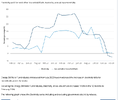- Joined
- 3 July 2009
- Posts
- 27,856
- Reactions
- 24,906
It gives everyone in NASA, time to get under a desk.A really spectacular solar flare would fry just about any electronic device it hit. Computers, cars, phones, IT infrastructure, substations. The last great solar flare of 1859 left a big impression. Not many computers then of course...
Apparently Science has now developed the capacity to predict such a disastrous event 30 minutes ahead of impact... I wonder how that would help the situation ?

NASA: We'd Have 30 Minutes' Warning Before a Killer Solar Storm Hits Earth
We've touched on the hazards of solar storms plenty of times in the past.www.sciencealert.com

The Carrington Event: History's greatest solar storm
Extreme solar storms such as the 1859 Carrington Event can play havoc with technology on Earth.www.space.com

Carrington Event - Wikipedia
en.wikipedia.org


